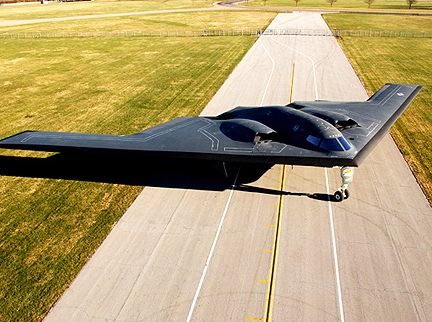Northrop Grumman... The Spirit Moves Them (MILSATCOM)
[SatNews] Northrop Grumman has initiated flight testing of new computing hardware and communications infrastructure that will eventually allow the B-2 stealth bomber to send and receive battlefield information by satellite more than 100x faster than today.

Since Sept. 1, the company has conducted a series of test flights using a
B-2 test aircraft stationed at
Edwards Air Force Base, Calif. The flight test program is part of
Increment 1 of the U.S. Air Force's B-2
extremely high frequency (
EHF) satellite communications program.
Northrop Grumman is the Air Force's prime contractor for the
B-2 Spirit, the flagship of the nation's long range strike arsenal, and one of the world's most survivable aircraft systems. The B-2 is the only combat-proven stealth platform in the current U.S. inventory. The EHF Increment 1 system that flew includes:
- A new integrated processing unit developed by Lockheed Martin Systems Integration, Owego, NY., that will replace up to a dozen current stand-alone avionics computers on the B-2
- A new disk drive unit developed by Honeywell Defense and Space Electronic Systems, Plymouth, Minn., that will enable transfer of EHF data onto and off of the B-2
- A network of fiber optic cable that will support the high speed data transfers within the aircraft
The three-increment
EHF Satcom program is part of an ongoing effort by the Air Force and Northrop Grumman to modernize the B-2 to keep it fully mission capable against evolving enemy threats.
Increment 2 involves installation of a new communications terminal and new antennas that will allow the B-2 to transmit and receive information securely via satellite.
Increment 3 will integrate the B-2 into the
U.S. Department of Defense's
Global Information Grid, a worldwide network of information systems, processes and personnel involved in collecting, storing, managing and disseminating information on demand to warfighters, policy makers and military support personnel.
Topical Tags :
Regional Tags :
 Since Sept. 1, the company has conducted a series of test flights using a B-2 test aircraft stationed at Edwards Air Force Base, Calif. The flight test program is part of Increment 1 of the U.S. Air Force's B-2 extremely high frequency (EHF) satellite communications program. Northrop Grumman is the Air Force's prime contractor for the B-2 Spirit, the flagship of the nation's long range strike arsenal, and one of the world's most survivable aircraft systems. The B-2 is the only combat-proven stealth platform in the current U.S. inventory. The EHF Increment 1 system that flew includes:
Since Sept. 1, the company has conducted a series of test flights using a B-2 test aircraft stationed at Edwards Air Force Base, Calif. The flight test program is part of Increment 1 of the U.S. Air Force's B-2 extremely high frequency (EHF) satellite communications program. Northrop Grumman is the Air Force's prime contractor for the B-2 Spirit, the flagship of the nation's long range strike arsenal, and one of the world's most survivable aircraft systems. The B-2 is the only combat-proven stealth platform in the current U.S. inventory. The EHF Increment 1 system that flew includes:

